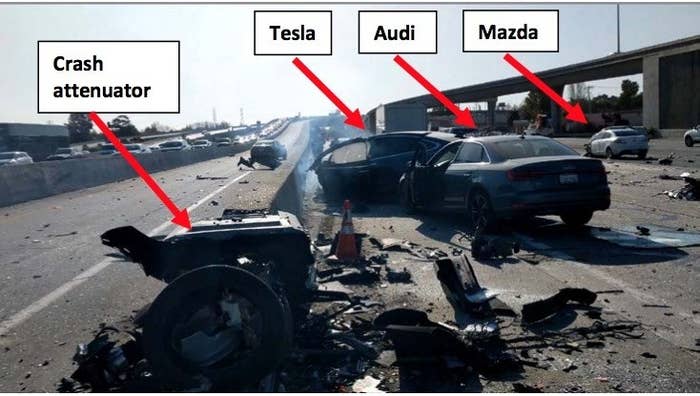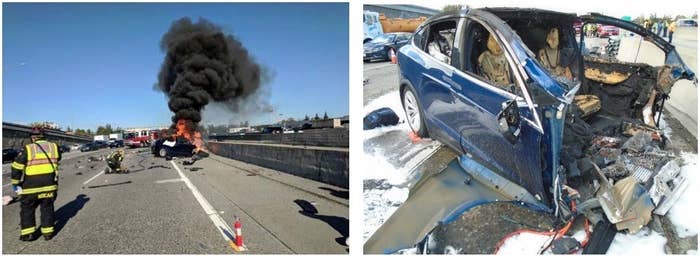
A preliminary report from the National Transportation Safety Board into a fatal Tesla crash in March found that the sedan was on autopilot when it accelerated into a barrier on a stretch of US Highway 101 in Mountain View, California.
“The Tesla’s speed increased — starting three seconds before impact and continuing until the crash — from 62 to 70.8 mph,” the report reads. “There was no braking or evasive steering detected prior to impact.”
The crash, which was well-publicized, and the ensuing report come during a period of increased scrutiny for Tesla, which is facing criticism for its marketing of driver assistance features. There have been several autopilot-related crashes since the feature was unveiled by the company in late 2014.
A Tesla spokesperson did not immediately return a request for comment.

According to the report, the Tesla Model X was “using the advanced driver assistance features traffic-aware cruise control and autosteer lane-keeping assistance,” or what Tesla calls “autopilot,” for almost 19 minutes before the collision.
During the incident, the car was traveling in a carpool lane, and increased its speed three seconds before hitting a crash attenuator. In the last six seconds, the vehicle did not detect the driver’s hands on the steering wheel.
The collision caused a breach of the car’s lithium-ion battery, igniting a fire that engulfed the car. Five days after the crash, according to the report, the battery reignited while the vehicle was in an impound lot.
The driver of the vehicle, an Apple engineer named Walter Huang, died at a local hospital after succumbing to injuries sustained in the crash. His family previously told BuzzFeed News that they are considering legal action against Tesla. An attorney representing the family issued a statement on Thursday and said "the Autopilot system should never have caused this to happen."
"Tesla also blames Walter’s alleged failure to pay attention as the sole cause of the accident. The NTSB report provides facts that support our concerns that there was a failure of both the Tesla Autopilot and the automatic braking systems of the car," said Mark Fong of Minami Tamaki LLP. "The report states that four seconds before the crash, Walter’s Tesla, under the control of the car’s Autopilot system, disengaged from following the car ahead and then accelerated at a high rate of speed into a fixed concrete highway barrier."
The NTSB issued an initial report on the most recent fatal Tesla crash this morning. Here's a statement from the attorneys representing the deceased driver's family, who are considering a lawsuit against Tesla. https://t.co/frajdR9oOQ
Tesla CEO Elon Musk has been critical of past coverage of Tesla crashes. Last month, he complained when a separate Tesla accident leading to a driver injury was covered by the Washington Post, when “~40,000 people who died in US auto accidents alone in past year get almost no coverage.” Critics have said that argument is disingenuous, given that Tesla has aggressively marketed its computer-assistance and autopilot features, and wants to be seen as a cutting-edge vehicle maker that is distinguished from the traditional auto industry.
The Tesla chief has also previously chided the NTSB.
“Lot of respect for NTSB, but [the National Highway Traffic Safety Administration] regulates cars, not NTSB, which is an advisory body,” he tweeted in April following a story that the agency was unhappy with the company’s comments on the March Model X crash. “Tesla releases critical crash data affecting public safety immediately & always will. To do otherwise would be unsafe.”
Caroline O'Donovan contributed reporting.
UPDATE
The story has been updated with comment from an attorney for the family of Walter Huang.
